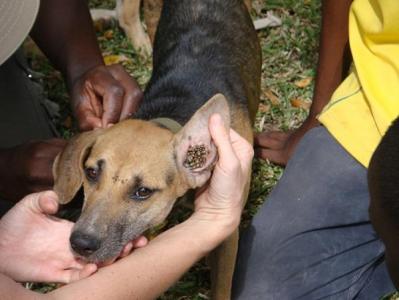How to fight and eliminate ticks from your dog completely

One of the most common problems associated with owning dogs is tick infestation. Ticks are blood-sucking insects that invade your dog’s body to feed and procreate. They appear as grey and ball-like bugs attached to the skin of the host (dog) when sucking blood. The newly hatched ticks appear brownish and small, difficult to kill by hand.
They are parasites to the dogs because they cause harm to the dogs with no benefit to the dog. Blood sucking activity is not the only issues associated with ticks, they also transmit some diseases to the dogs during their blood sucking activities to cause various blood related illnesses to the dog like Erlichiosis and Babesiosis among others.
The presence of ticks on your dog is not only irritating to the eyes but also very discomforting to the dogs.
How do we eliminate them from the dogs?
It’s important to note that the process of elimination may not just happen once because just like mosquitoes in humans, they keep coming back one way or the other. Consequently, it’s important to have an elimination program to tackle them.
1. Be very vigilant to observe when they come back to your dog. You should routinely check your dogs weekly for infestation. Look into the dogs ears, between the paws and digits (fingers or toes) and the inguinal area to find the ticks. Ticks love to attach at mostly hairless and closed areas of the body. If ticks are present.
2. Decide the measure to take to remove them from the body of the dog. It is not advisable to pick the ticks out of the body of the dog by hand although there is an instrument for doing that. A lot of Nigerians do this and get away with it without losing their dogs but it’s not the best way.
3. You may choose to use acaricides in form of powder if your dog is a puppy. Just dust the puppy’s body with the powder all through even inside the ears but make sure the puppy is dry. Most powders provides 7 days protection to the puppy.
4. Choose an acaricide emulsion that are mixed in water and used to bathe the dogs to get rid of ticks within hours.
5. Tick sprays are available to eliminate ticks and protect the dog against infestations for a certain period of time.
6. Spray the environment with insecticides (“fumigationâ€) to eliminate the ticks hiding. Note that the insecticides only kill ticks that have already hatched from the eggs because it acts through their respiratory system to kill them. The ticks still in the eggs are not affected by this process. Please make sure to take your dog far away from the compound before spraying the environment to avoid death of the dogs.
It’s important to note that this process might not be cheap and it might also be very technical in that you might need a little training to do it well and properly. This is what I cannot write here in other to keep this article short and straight to the point.
My own recommendation to my clients is to first bath the dog with the emulsion acaricide (the most popular of this is Amitraz 20 or simply Amiraz) with the right mixture in water and subsequently allow the dog to dry. Give some time to allow the ticks to drop off. Apply the tick spray to prevent further infestation. I always recommend a fipronil spray like P-Guard spray, Frontline spray, Protector spray or Fiproprotector sprays. This category of sprays lasts for 6 weeks on the skin of the dog and protects the dog for that long, provided they are not given a bath or beaten by rain which will wash off the spray. Fipronil sprays are mild enough to be used both on puppies and adult dogs. Lastly, remove the dogs for 12 – 24hrs from the environment and spray the environment with insecticides such as Sniper ®.
If you do this my recommendation once every 3 months you will successfully eliminate the ticks completely.
I strongly will advise you not to use the emulsion acaricide (eg. Amitraz 20) on a sick dog because the dog might die even before you finish the bath. It’s important to check and confirm that the dog is fit for the bath. Do not use the same on puppies below 3 months especially the emulsions containing pyrethrins because the dog will itch and salivate for a long time.
Please consult a qualified veterinary doctor for proper guidance on how to use these products regarding the state of health of your dog.
Thank You.









Splendid, beautiful, Great lesson Thanks
Leave a Reply
Excellent advise.
Leave a Reply